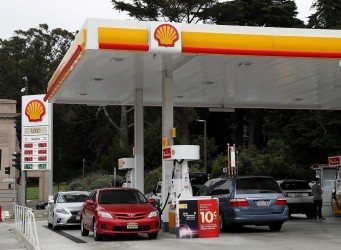New climate assessment likely to spark action by companies; Congress, not so much
Evan Lehmann, E&E reporter
Published: Monday, September 30, 2013
From parched cotton fields to soaked shorelines, the enhanced risks of climate change outlined by scientists of the Intergovernmental Panel on Climate Change (IPCC) last week provide a new road map to help businesses anticipate financial hazards, analysts say.
The release Friday of the world’s first compilation of climate research in six years clarifies the potential impacts of hurricanes, drought and thunderstorms for insurance companies with policies worth trillions of dollars in cities that are becoming increasingly dense.
It could help investors choose where to place their money, and where not to. And it might also help clothing companies, like VF Corp., prepare for financial threats from shorter winters and disturbed growing seasons.
“Climate change is disrupting all aspects of our global economy, including supply chains, commodity markets and the entire insurance industry, which is seeing exponentially larger losses from extreme weather events,“said Mindy Lubber, president of Ceres, a group of institutional investors that supports efforts to reduce greenhouse gas emissions.
The summary report released by the IPCC comes as many U.S. companies are reducing their carbon footprints, conserving energy and trying to please “climate-aware” customers, she said.
“There are definitely some holdouts with vested interests that may claim otherwise, but the fact could not be more clear,” Lubber said. “The vast majority of businesses and investors are understanding this financial risk and are starting to move from the old debate to a new debate.”
One reason for those changes is the attention drawn to climbing temperatures by the IPCC’s last report, released in 2007. At the time, the panel of scientists said it was 90 percent certain that global temperature increases were caused predominantly by human-related emissions. That acted as a “stimulus” for corporations to address their contributions to warming, said Nick Robins, head of the Climate Change Centre of Excellence at HSBC, the banking and financial services giant.
‘Weather on steroids’
“What we’re doing at the moment, through uncontrolled emissions of greenhouse gases, is we’re putting weather on steroids,” Robins said on a conference call organized by Ceres on Friday. “And we’re heading into a very, very dangerous place for the global economy.”
He pointed to nations with promising economic futures like Brazil, China, India and South Africa as being particularly threatened by financial and social challenges under severe climate scenarios.
The IPCC is now 95 percent certain that human activity is responsible for the global rise in temperature since 1880, about 1.5 degrees Fahrenheit.
Those findings could spark additional action among corporations to cut their emissions, protect their facilities from flooding, strengthen their supply chains and save energy, Robins said.
“I think we do see the beginning of a renewal of an impetus in the policy and business world,” he said.
Climate policies remain frozen in the U.S. Congress. Even narrow efforts like an energy efficiency bill supported by members of both political parties in the Senate failed to find traction in the ultra-partisan Capitol earlier this month.
But there are signs within some sectors of the economy that businesses aren’t waiting. They are taking the disparate risks of climate change seriously. Entergy Corp., which provides electric power to almost 3 million customers in Gulf Coast states, released a report in the past year finding that economic losses in the region could rise by up to 65 percent by 2030. Those damages are driven by increased development, sinking land, rising oceans and other climate impacts, the company said.
The Gulf Coast currently experiences $14 billion in economic losses annually from disasters. In the next 17 years, they could climb to $23 billion if climate change isn’t addressed, according to the Entergy report.
The CDP, formerly known as the Carbon Disclosure Project, reported this year that 334 of the Standard & Poor’s 500 companies now disclose their carbon footprints. Together, they cut their emissions by 6.1 percent in 2012. Much of that can be attributed to increased use of natural gas and renewable energy, along with a slower economy, but CDP also says that the companies’ emission targets played a role.
About 75 percent of the companies reporting to CDP had implemented reduction goals. But the group also notes that about half of those companies are in line to meet their targets.
For VF Corp., the parent of North Face, Timberland and Nautica, climbing temperatures are causing uncertainty that affects its bottom line. The company is among the world’s largest cotton buyers, gobbling up about 1 percent of the global supply every year to make clothing.
The specific impact of climate change on the commodity is unclear, but the company has little doubt that drier conditions and unpredictable storms in growing regions will batter its business plans.
“So the impacts are real,” said Letitia Webster, VF’s director of global corporate sustainability. “And what we’re really seeing, then, is the fluctuation in cotton prices are going to be dramatically impacting the price of our products at retail and therefore even our profitability.”
Certainty about sea-level rise, but not hurricanes
She also anticipates other impacts. With the winter skiing season now about two weeks shorter, she said, the shopping period for North Face jackets, pants and outdoor gear has also been clipped. In the future, regulations on carbon emissions could pose other challenges. Many of the company’s products, like tents, are made of synthetic material, which is derived from petroleum.
For all the help that the IPCC report might lend to business risk managers, it also stands to fuel indecision. The panel is unequivocal about the role that greenhouse gases play in pushing temperatures up. But it’s uncertain about the actual impacts of those heat increases on some atmospheric systems, like hurricanes.
The IPCC’s summary released Friday finds “low confidence” that humans are making intense hurricanes stronger. That promises to make it difficult for insurers to interpret future risks related to their shoreline assets.
“Improved observations show there is little evidence of any long-term global increases in tropical cyclone activity,” said Brian Soden, a professor at the University of Miami and a lead author on surface observations in the IPCC report.
On the other hand, the panel increased its confidence around sea-level rise from an uppermost prediction of 0.59 meter by 2100 six years ago to about 1 meter now.
So even as scientists can’t find consensus on the behavior of hurricanes, coastal flooding during storms — whether they’re sharpened by warming or not — promises to get worse.
“Even looking at near-term projections of what sea level could be like within my lifetime, I think it will certainly have dramatic impacts where I live,” said Soden, who lives in South Florida.



